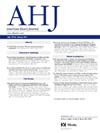鼓励处方SGLT2i和GLP-1RA药物以降低2型糖尿病患者心血管和肾脏风险:一项随机对照试验的原理和设计
IF 3.7
2区 医学
Q1 CARDIAC & CARDIOVASCULAR SYSTEMS
引用次数: 0
摘要
背景:钠-葡萄糖共转运蛋白-2抑制剂(SGLT2i)和胰高血糖素样肽-1受体激动剂(GLP-1RA)药物可降低2型糖尿病患者心血管和肾脏并发症的风险,但未得到充分利用。开处方有许多障碍,包括保险覆盖范围、药物可用性、开处方的舒适性以及在专家之间分散开处方的责任。需要有支持初级保健处方的方法。方法:这是一项实用的随机对照试验,测试干预措施以增加适当的SGLT2i和GLP-1RA处方。初级保健提供者(pcp)随机分为三组:1)同伴冠军支持,2)同伴冠军支持和保险覆盖信息,或3)常规护理(无干预)。两个干预组的pcp在访问糖尿病控制欠佳且有其中一种药物适应症的患者之前,都会收到一封欢迎邮件和电子健康记录(EHR)信息。在同行冠军的支持下,只有手臂的电子病历信息包括处方提示。在提供同行冠军支持和保险覆盖信息的部门,电子病历信息包含了基于其保险覆盖范围的患者最负担得起的每一类药物的信息,并在需要时为事先授权提供支持。主要结果是与对照组相比,每个干预组的SGLT2i或GLP-1RA药物处方从目标访问前3天开始,持续28天。结果:191名初级保健提供者被纳入研究。在6个月的干预期间,1389名患者至少安排了一次PCP就诊;在这1079名患者中,至少参加了一次这些访问,并将纳入主要结局分析。66名提供者(484例患者)单独接受同伴冠军干预,63名提供者(446例患者)接受同伴冠军干预和保险覆盖信息,62名提供者(459例患者)接受常规护理。患者平均年龄为66岁,46%为女性,61%为白人,16%为西班牙裔。在患者的性别、种族、民族、伴侣状况和医疗保险的百分比方面,两组之间存在微小差异。结论:这些药物类别有可能减少2型糖尿病患者的心血管和肾脏疾病。本研究测试干预措施,以支持这些药物的处方在初级保健。本文章由计算机程序翻译,如有差异,请以英文原文为准。
Encouraging the prescribing of SGLT2i and GLP-1RA medications to reduce cardiovascular and renal risk in patients with type 2 diabetes: Rationale and design of a randomized controlled trial
Background
Sodium-glucose cotransporter-2 inhibitor (SGLT2i) and glucagon-like peptide-1 receptor agonist (GLP-1RA) medications reduce the risk of cardiovascular and renal complications among patients with type 2 diabetes but are underutilized. There are numerous barriers to prescribing including insurance coverage, medication availability, comfort with prescribing, and diffusion of responsibility of prescribing across specialists. Methods are needed to support prescribing in primary care.
Methods
This was a pragmatic, randomized controlled trial testing interventions to increase appropriate SGLT2i and GLP-1RA prescribing. Primary care providers (PCPs) were randomized to 1 of 3 arms: (1) peer champion support (2) peer champion support and information on insurance coverage, or (3) usual care (no intervention). PCPs in both intervention arms received a welcome email and electronic health record (EHR) messages before visits with patients who had sub-optimally controlled diabetes and an indication for 1 of these medications. In the peer champion support only arm the EHR messages included prescribing tips. In the arm that provided peer champion support and information on insurance coverage, EHR messages contained information on medications in each class that would be most affordable for the patient based on their insurance coverage and offered support for prior authorizations if needed. The primary outcome was prescriptions for an SGLT2i or GLP-1RA medication, beginning 3 days before the targeted visit and continuing through 28 days, in each intervention arm compared to control.
Results
191 primary care providers were included in the study. 1,389 patients had at least 1 visit scheduled with their PCP during the 6-month intervention period; of these 1,079 patients attended at least 1 of these visits and will be included in the primary outcome analysis. 66 providers (484 patients) received the peer champion intervention alone, 63 providers (446 patients) received the peer champion intervention and information on insurance coverage, and 62 providers (459 patients) received usual care. On average, patients were 66 years old, 46% were female, 61% were white, and 16% were Hispanic. There were small differences between groups with regards to patient sex, race, ethnicity, partner status, and percent with Medicare insurance.
Conclusions
These medication classes have the potential to reduce cardiovascular and kidney disease among patients with type 2 diabetes. This study tests interventions to support prescribing of these medications in primary care.
Clinical Trial
Clinicaltrials.gov. Unique identifier: (NCT, Registered: NCT05463705).
求助全文
通过发布文献求助,成功后即可免费获取论文全文。
去求助
来源期刊

American heart journal
医学-心血管系统
CiteScore
8.20
自引率
2.10%
发文量
214
审稿时长
38 days
期刊介绍:
The American Heart Journal will consider for publication suitable articles on topics pertaining to the broad discipline of cardiovascular disease. Our goal is to provide the reader primary investigation, scholarly review, and opinion concerning the practice of cardiovascular medicine. We especially encourage submission of 3 types of reports that are not frequently seen in cardiovascular journals: negative clinical studies, reports on study designs, and studies involving the organization of medical care. The Journal does not accept individual case reports or original articles involving bench laboratory or animal research.
 求助内容:
求助内容: 应助结果提醒方式:
应助结果提醒方式:


